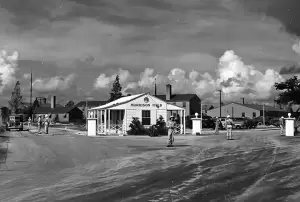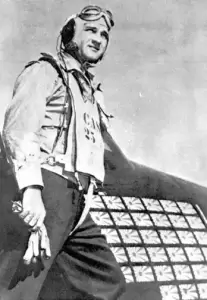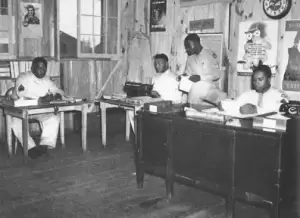U.S. Military in West Palm Beach

Field, 1943
In 1940 the U.S. Army Air Corps, forerunner of the U.S. Air Force, established Air Transport Command at Morrison Field, which had opened in 1936 west of West Palm Beach. The army added barracks and other buildings, and a hangar for the 3,000 soldiers who would be stationed there during the coming war.
More than 45,000 pilots either trained or flew out of West Palm Beach for destinations such as the invasion of Normandy, France, on D-Day. As many as 250 women from the Women’s Army Corps (WACS) also served at Morrison Field. The 313th Material Squadron from Miami Municipal Airport moved to Morrison Field in April 1942 to handle air cargo and maintain both airport and aircraft. A thousand men worked around the clock to overhaul, repair, and flight-test aircraft before returning them to service.

The 308th Bombardment Group, the 3rd Combat Cargo Group, and others flew between Morrison Field and India, from which they made trips to China. The trip, which was nicknamed “flying the hump,” over the Himalayas Mountains, took over two weeks each way. The planes made stops in Puerto Rico, British Guinea, and Brazil before the 1428 miles across the ocean without refueling to Ascension Island. From there, they stopped in Liberia, then flew up the west coast of Africa and across the Sahara Desert to French Morocco in North Africa, and on to India. Military secrecy demanded that Palm Beach County’s civilians had little idea of the importance of this command until after it was deactivated in 1947.
The Army Air Force established the 1st Air Weather Group at Morrison Field in 1946 to administer, train, equip, and organize the four weather reconnaissance squadrons then assigned to the Air Weather Service, which had started its first squadron in Ohio in 1942. The 55th Squadron flew a B-29 over a hurricane for the first time from Morrison Field on October 7, 1946, with three photographers and a public relations officer on board to cover the event.
Morrison Field was deactivated in June 1947 and returned to Palm Beach County. A year later, county commissioners voted to rename the facility Palm Beach International Airport, though the community had mixed feelings about losing the name that held historical significance, and that thousands of former service men and women might choose to revisit.

From 1951 to 1953 the airport served its country again as Morrison Air Force Base, where 23,000 airmen trained during the Korean War. A new terminal was dedicated in 1988 to U.S. Navy Commander David McCampbell (1910-1996), a lifelong resident of Palm Beach County and World War II flying ace who received the Congressional Medal of Honor.
Mosquito boots. . . ?

All the flights that came through Morrison Field stopped in order to pick up anything that they needed—for instance, I remember one shipment, they needed mosquito boots. … a very soft boot that they had to wear when they were in Africa to protect them from mosquitoes. … One of the things they needed one time was flashlights, and when I got through [filling the order], there wasn’t a flashlight between Fort Pierce and Boca Raton or Pompano, over to Belle Glade. I went to work for $1,260 a year. The colored folks who came in, they were working for $1,200 a year, and that was twice as much as they had ever made before. I couldn’t get to second grade, which would’ve been a typist, and that was at $1,440 a year, but I couldn’t type that well.

